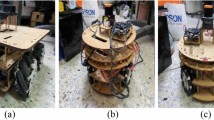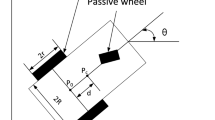Abstract
This article investigates the cooperative tracking control of multiple homogeneous uncertain nonholonomic wheeled mobile robots with state constraints. Transforming each mobile robot system into a chained form, a cooperative learning control scheme based on the adaptive neural network is proposed. Firstly, a virtual control law is designed for the kinematic model of the constrained chain system combined with the barrier Lyapunov function (BLF). Then, radial basis function neural networks (RBF NNs) are exploited to deal with the unknown nonlinear dynamics in the mobile robot system, a robust term is introduced to compensate for the NN approximation errors and the external disturbance, and the Moore–Penrose inverse is adopted to avoid the violation of state constraints. Communication network is used to realize the online sharing of NN weights of each mobile robot individuals, such that locally accurate identification of the unknown nonlinear dynamics with common optimal weights can be obtained. As a result, the learned knowledge can be reused in the cooperative learning control tasks and the trained network model has better generalization capabilities than the normal decentralized learning control. Finally, numerical simulation verifies the effectiveness of the control scheme.














Similar content being viewed by others
References
Shao J, Xie G, Wang L (2007) Leader-following formation control of multiple mobile vehicles. IET Control Theory Appl 1(2):545–552. https://doi.org/10.1049/iet-cta:20050371
Defoort M, Floquet T, Kokosy A, Perruquetti W (2008) Sliding-mode formation control for cooperative autonomous mobile robots. IEEE Trans Ind Electron 55(11):3944–3953. https://doi.org/10.1109/TIE.2008.2002717
Balch T, Arkin RC (1998) Behavior-based formation control for multirobot teams. IEEE Trans Robot Autom 14(6):926–939. https://doi.org/10.1109/70.736776
Ghommam J, Mehrjerdi H, Saad M, Mnif F (2010) Formation path following control of unicycle-type mobile robots. Robot Auton Syst 58(5):727–736. https://doi.org/10.1016/j.robot.2009.10.007
Cao K-C, Jiang B, Yue D (2017) Cooperative path following control of multiple nonholonomic mobile robots. ISA Trans 71:161–169. https://doi.org/10.1016/j.isatra.2017.06.028
Han SI (2018) Prescribed consensus and formation error constrained finite-time sliding mode control for multi-agent mobile robot systems. IET Control Theory Appl 12(2):282–290. https://doi.org/10.1049/iet-cta.2017.0351
Desai JP, Ostrowski JP, Kumar V (2001) Modeling and control of formations of nonholonomic mobile robots. IEEE Trans Robot Autom 17(6):905–908. https://doi.org/10.1109/70.976023
Consolini L, Morbidi F, Prattichizzo D, Tosques M (2008) Leader-follower formation control of nonholonomic mobile robots with input constraints. Automatica 44(5):1343–1349. https://doi.org/10.1016/j.automatica.2007.09.019
Peng Z, Yang S, Wen G, Rahmani A (2014) Distributed consensus-based robust adaptive formation control for nonholonomic mobile robots with partial known dynamics. Math Probl Eng. https://doi.org/10.1155/2014/670497
Peng Z, Wen G, Rahmani A, Yu Y (2015) Distributed consensus-based formation control for multiple nonholonomic mobile robots with a specified reference trajectory. Int J Syst Sci 46(8):1447–1457. https://doi.org/10.1080/00207721.2013.822609
Peng Z, Yang S, Wen G, Rahmani A, Yu Y (2016) Adaptive distributed formation control for multiple nonholonomic wheeled mobile robots. Neurocomput 173:1485–1494. https://doi.org/10.1016/j.neucom.2015.09.022
Dierks T, Jagannathan S (2009) Neural network control of mobile robot formations using RISE feedback. IEEE Trans Syst Man, Cybern, Part B: Cybern 39(2):332–347. https://doi.org/10.1109/TSMCB.2008.2005122
Li Z, Yuan W, Chen Y, Ke F, Chu X, Chen CLP (2018) Neural-dynamic optimization-based model predictive control for tracking and formation of nonholonomic multirobot systems. IEEE Trans Neural Netw Learn Syst 29(12):6113–6122. https://doi.org/10.1109/TNNLS.2018.2818127
Dong W, Farrell JA (2009) Decentralized cooperative control of multiple nonholonomic dynamic systems with uncertainty. Automatica 45(3):706–710. https://doi.org/10.1016/j.automatica.2008.09.015
Wu H-M, Karkoub M, Hwang C-L (2015) Mixed fuzzy sliding-mode tracking with backstepping formation control for multi-nonholonomic mobile robots subject to uncertainties: category (3), (5). J Intell Robot Syst: Theory Appl 79(1):73–86. https://doi.org/10.1007/s10846-014-0131-9
Cheng Y, Jia R, Du H, Wen G, Zhu W (2018) Robust finite-time consensus formation control for multiple nonholonomic wheeled mobile robots via output feedback. Int J Robust Nonlinear Control 28(6):2082–2096. https://doi.org/10.1002/rnc.4002
Do KD, Pan J (2007) Nonlinear formation control of unicycle-type mobile robots. Robot Auton Syst 55(3):191–204. https://doi.org/10.1016/j.robot.2006.09.001
Wang G, Wang C, Du Q, Li L, Dong W (2016) Distributed cooperative control of multiple nonholonomic mobile robots. J Intell Robot Syst: Theory Appl 83(3–4):525–541. https://doi.org/10.1007/s10846-015-0316-x
Dierks T, Jagannathan S Control of nonholonomic mobile robot formations: Backstepping kinematics into dynamics. In: 16th IEEE International Conference on Control Applications, CCA 2007. Part of IEEE Multi-conference on Systems and Control, October 1, 2007 - October 3, 2007, Singapore, 2007. Proceedings of the IEEE International Conference on Control Applications. Institute of Electrical and Electronics Engineers Inc., pp 94-99. https://doi.org/10.1109/CCA.2007.4389212
Dierks T, Jagannathan S (2009) Asymptotic adaptive neural network tracking control of nonholonomic mobile robot formations. J Intell Robot Syst: Theory Appl 56(1–2):153–176. https://doi.org/10.1007/s10846-009-9336-8
Peng Z, Wen G, Yang S, Rahmani A (2016) Distributed consensus-based formation control for nonholonomic wheeled mobile robots using adaptive neural network. Nonlinear Dyn 86(1):605–622. https://doi.org/10.1007/s11071-016-2910-2
Shojaei K (2017) Neural adaptive output feedback formation control of type (m, s) wheeled mobile robots. IET Control Theory Appl 11(4):504–515. https://doi.org/10.1049/iet-cta.2016.0952
Wang C, Hill DJ (2006) Learning from neural control. IEEE Trans Neural Netw 17(1):130–146. https://doi.org/10.1109/TNN.2005.860843
Wu Y, Wang C (2014) Adaptive neural control and learning of affine nonlinear systems. Neural Comput Appl 25(2):309–319. https://doi.org/10.1007/s00521-013-1488-6
Dai S-L, Wang C, Wang M (2014) Dynamic learning from adaptive neural network control of a class of nonaffine nonlinear systems. IEEE Trans Neural Netw Learn Syst 25(1):111–123. https://doi.org/10.1109/TNNLS.2013.2257843
Wang M, Wang C, Shi P, Liu X (2016) Dynamic learning from neural control for strict-feedback systems with guaranteed predefined performance. IEEE Trans Neural Netw Learn Syst 27(12):2564–2576. https://doi.org/10.1109/TNNLS.2015.2496622
Chen W, Hua S, Zhang H (2015) Consensus-based distributed cooperative learning from closed-loop neural control systems. IEEE Trans Neural Netw Learn Syst 26(2):331–345. https://doi.org/10.1109/TNNLS.2014.2315535
Yang H, Guo M, Xia Y, Cheng L (2018) Trajectory tracking for wheeled mobile robots via model predictive control with softening constraints. IET Control Theory Appl 12(2):206–214. https://doi.org/10.1049/iet-cta.2017.0395
Zamani MR, Rahmani Z, Rezaie B (2020) A novel model predictive control strategy for constrained and unconstrained systems in presence of disturbance. IMA J Math Control Inf 37(1):208–225. https://doi.org/10.1093/imamci/dny046
Wu Y, Huang R, Li X, Liu S (2019) Adaptive neural network control of uncertain robotic manipulators with external disturbance and time-varying output constraints. Neurocomput 323:108–116. https://doi.org/10.1016/j.neucom.2018.09.072
He W, Huang H, Ge SS (2017) Adaptive neural network control of a robotic manipulator with time-varying output constraints. IEEE Trans Cybern 47(10):3136–3147. https://doi.org/10.1109/TCYB.2017.2711961
Tee KP, Ge SS, Tay EH (2009) Barrier Lyapunov Functions for the control of output-constrained nonlinear systems. Automatica 45(4):918–927. https://doi.org/10.1016/j.automatica.2008.11.017
He W, Chen Y, Yin Z (2016) Adaptive neural network control of an uncertain robot with full-state constraints. IEEE Transactions on Cybernetics 46(3):620–629. https://doi.org/10.1109/TCYB.2015.2411285
A. J. Laub (2004) Matrix Analysis for Scientists and Engineers. Soc Ind Appl Math
Agaev R, Chebotarev P (2006) The matrix of maximum out forests of a digraph and its applications. Autom Remote Control 61(9):1424–1450
Panteley E, Loria A, Teel A (2001) Relaxed persistency of excitation for uniform asymptotic stability. IEEE Trans Autom Control 46(12):1874–1886. https://doi.org/10.1109/9.975471
Chen W, Wen C, Hua S, Sun C (2014) Distributed cooperative adaptive identification and control for a group of continuous-time systems with a cooperative PE condition via consensus. IEEE Trans Autom Control 59(1):91–106. https://doi.org/10.1109/TAC.2013.2278135
Shojaei K, Shahri AM (2012) Adaptive robust time-varying control of uncertain non-holonomic robotic systems. IET Control Theory Appl 6(1):90–102. https://doi.org/10.1049/iet-cta.2010.0655
Murray RM, Sastry SS (1993) Non-holonomic motion planning: steering using sinusoids. IEEE Trans Autom Control 38(5):700–716
Zhao Z, He W, Ge SS (2014) Adaptive neural network control of a fully actuated marine surface vessel with multiple output constraints. IEEE Trans Control Syst Technol 22(4):1536–1543. https://doi.org/10.1109/TCST.2013.2281211
Jiang Z-P (2000) Lyapunov design of global state and output feedback trackers for non-holonomic control systems. Int J Control 73(9):744–761. https://doi.org/10.1080/00207170050029250
Sirouspour MR, Salcudean SE (2001) Nonlinear control of hydraulic robots. IEEE Trans Robot Autom 17(2):173–182. https://doi.org/10.1109/70.928562
Acknowledgements
This work is supported by Science and Technology Planning Project of Guangdong Province, China [2015B010133 002, 2017B090910011].
Author information
Authors and Affiliations
Corresponding author
Ethics declarations
Conflict of interest
The authors have no conflicts of interest to declare that are relevant to the content of this article..
Additional information
Publisher's Note
Springer Nature remains neutral with regard to jurisdictional claims in published maps and institutional affiliations.
Rights and permissions
About this article
Cite this article
Wu, Y., Wang, Y., Fang, H. et al. Cooperative learning control of uncertain nonholonomic wheeled mobile robots with state constraints. Neural Comput & Applic 33, 17551–17568 (2021). https://doi.org/10.1007/s00521-021-06342-7
Received:
Accepted:
Published:
Issue Date:
DOI: https://doi.org/10.1007/s00521-021-06342-7




